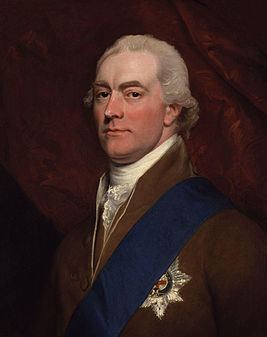Monarch George III Nationality British Political party Whig | Preceded by The Lord Hawkesbury Name George 2nd Succeeded by The Lord Hawkesbury | |
 | ||
Children John Spencer, Viscount Althorp, Frederick Spencer, 4th Earl Spencer, Sarah Lyttelton, Baroness Lyttelton Parents John Spencer, 1st Earl Spencer, Georgiana Spencer, Countess Spencer Siblings Georgiana Cavendish, Duchess of Devonshire, Henrietta Ponsonby, Countess of Bessborough Similar People Georgiana Cavendish - Duchess, William Cavendish - 5th Duke, Georgiana Spencer - Countess, Charles Spencer - 6th Earl S, William Cavendish - 6th Duke | ||
Prime Minister The Lord Grenville | ||
George John Spencer, 2nd Earl Spencer, (1 September 1758 – 10 November 1834), styled Viscount Althorp from 1765 to 1783, was a British Whig politician. He notably served as Home Secretary from 1806 to 1807 in the Ministry of All the Talents.
Contents
- Background and education
- Political career
- Other public positions
- Book collecting
- Family
- Spencer jacket
- Styles of address
- References

Background and education
Lord Spencer was born at Wimbledon Park, London, the son of John Spencer, 1st Earl Spencer, and his wife Margaret Georgiana Poyntz, daughter of Stephen Poyntz, and was baptised there on 16 October 1758. His godparents were King George II, the Earl Cowper (his grandmother's second husband) and his great-aunt the Dowager Viscountess Bateman. His sister Lady Georgiana married the Duke of Devonshire and became a famed Whig hostess. He was educated at Harrow School from 1770 to 1775 and he won the school's Silver Arrow (an archery prize) in 1771. He then attended Trinity College, Cambridge, from 1776 to 1778 and graduated with a Master of Arts. He acceded to the earldom upon the death of his father in 1783.
Political career
Lord Spencer was Whig Member of Parliament for Northampton from 1780 to 1782 and Whig MP for Surrey from 1782 to 1783. He was sworn of the Privy Council in 1794 and served under William Pitt the Younger as Lord Privy Seal in 1794 and as First Lord of the Admiralty from 1794 to 1801. He was later Home Secretary from 1806 to 1807 under Lord Grenville in the Ministry of All the Talents.
Other public positions
Lord Spencer was also High Steward of St Albans from 1783 to 1807, Mayor of St Albans in 1790, President of the Royal Institution from 1813 to 1825 and Commissioner of the Public Records in 1831. He became a Fellow of the Royal Society in 1780 and a Fellow of the Society of Antiquaries of London in 1785. He was appointed to the Order of the Garter in 1799. On 18 February 1793, he was appointed a deputy lieutenant of Northamptonshire.
Book collecting
Spencer was noted for his interest in literature and particularly in early examples of printing. He was the instigator and first President of the Roxburghe Club (an exclusive bibliophilic club), founded in 1812. When Napoleon instigated the secularization of religious houses in south Germany, Spencer used local British agent and Benedictine monk, Alexander Horn, to acquire many of their rare books and manuscripts.
His collection of tens of thousands of volumes, which included the most nearly complete collection of Aldine editions ever brought together, was put up for sale in 1892 and acquired by Enriqueta Rylands for the John Rylands Library and it was indexed by Alice Margaret Cooke.
Family
Lord Spencer married Lady Lavinia Bingham (1762–1831), daughter of Charles Bingham, 1st Earl of Lucan, on 6 March 1781. They had nine children:
Lady Spencer died in June 1831, aged 68. Lord Spencer survived her by three years and died in November 1834, aged 76, at Althorp, and was buried in the nearby village of Great Brington on 19 November of that year.
Spencer jacket
The Spencer, a type of short jacket from which the UK military mess jacket is derived, is named for George Spencer, reportedly because he had a tail-coat adapted after its tails were burned by coals from a fire.
